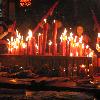

On Chinese New Year Tags: Chinese New Year View |
Tags: Chinese New Year View |
Tags: Chinese New Year View |
|||||||||
Chinese New Year, Lunar New Year, or Spring Festival is the most important of the traditional Chinese holidays. It is commonly called "Lunar New Year", because it is based on the lunisolar (lunisolar calendar) Chinese calendar. The festival traditionally begins on the first day of the first month (zhc=??p=zh?ng yu�) in the Chinese calendar and ends with Lantern Festival which is on the 15th day. Chinese New Years Eve is known as ch� x?. It literally means "Year-pass Eve".
Chinese New Year is the longest and most important festivity in the Chinese Lunar Calendar. The origin of Chinese New Year is itself centuries old and gains significance because of several myths and traditions. Ancient Chinese New Year is a reflection on how the people behaved and what they believed in the most.
Chinese New Year is celebrated in countries and territories with significant Han Chinese populations (Chinatowns), such as Mainland China, Hong Kong, Macau, Singapore, Taiwan, Indonesia, Laos, Malaysia, the Philippines, and Thailand. Chinese New Year is considered a major holiday for the Chinese and has had influence on the new year celebrations of its geographic neighbors, as well as cultures with whom the Chinese have had extensive interaction. These include Koreans (Seollal), Tibetans and Bhutanese (Losar), Mongolians (Tsagaan Sar), Vietnamese (Vietnamese people) (T?t), and the Japanese (Japanese people) before 1873 (Oshogatsu). In countries such as Australia, Canada and the United States, although Chinese New Year is not an official holiday, many ethnic Chinese hold large celebrations and Australia Post, Canada Post, and the US Postal Service issue New Years themed stamps.
Within China, regional customs and traditions concerning the celebration of the Chinese new year vary widely. People will pour out their money to buy presents, decoration, material, food, and clothing. It is also the tradition that every family thoroughly cleans the house to sweep away any ill-fortune in hopes to make way for good incoming luck. Windows and doors will be decorated with red colour paper-cuts (Chinese paper cutting) and couplets (Duilian) with popular themes of ?happiness?, ?wealth?, and ?longevity?. On the Eve of Chinese New Year, supper is a feast with families. Food will include such items as pigs, ducks, chicken and sweet delicacies. The family will end the night with firecrackers. Early the next morning, children will greet their parents by wishing them a healthy and happy new year, and receive money in red paper envelopes. The Chinese New Year tradition is a great way to reconcile; forgetting all grudges, and sincerely wish peace and happiness for everyone.
Although the Chinese calendar traditionally does not use continuously numbered years, outside China its years are often numbered from the reign of the Yellow Emperor, Huangdi. But at least three different years numbered 1 are now used by various scholars, making the year 2010 "Chinese Year" 4708, 4707, or 4647.
Holiday Name: Chinese New Year
Allias Name: Lunar New Year, Spring Festival
Observedby: Chinese (Han Chinese) communities worldwide
Date2010: February 14
Date2011: February 3
Date2012: January 23
Date2013: February 10
Date2014: January 31
Date2015: February 19
Date2016: February 8
Date2017: January 28
Date2018: February 16
Date2019: February 5
Date2020: January 25
Type: Asian festival
Longtype: Cultural (Culture of China), Religious,(Buddhist (Chinese Buddhism), Daoist, Confucian)
Significance: The first day of the Chinese calendar (lunar calendar)
Relatedto: Lantern Festival, which concludes the celebration of the New Year. ,Mongolian New Year (Tsagaan Sar), Tibetan New Year (Losar), Japanese New Year, Korean New Year, Vietnamese New Year (T?t)
Celebrations: Dragon dances/Lion dances, fireworks, family gathering, family meal, visiting friends and relatives (??), giving red envelopes, decorating with duilian (??). Contains Chinese text



